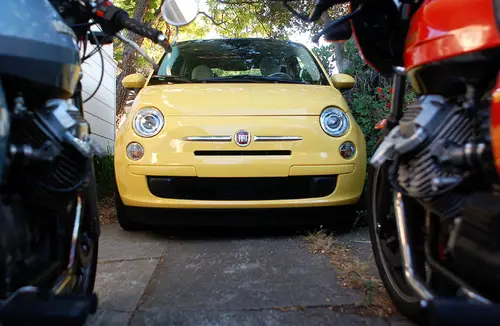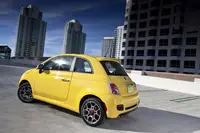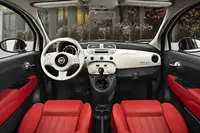2014 Fiat 500 Pop Hatchback with 2015 Updates by Carey Russ +VIDEO
 2014 Fiat 500 nestled between two Guzzis |
The modern Cinquecento continues to provide maximum driving pleasure with minimal thirst, and in high style
DRIVING DOWN THE ROAD WITH CAREY RUSS
• SEE ALSO: Fiat Buyers Guide
 2014 Fiat 500 |
The Fiat 500 has changed little since its American debut in 2011 for model year 2012, and no complaints there. The Fiat lineup has filled out, with the original two-door hatchback joined by the Abarth performance variant, the Turbo between the regular and Abarth models, convertibles in regular and Abarth tune, an electric model of the hatchback, and the larger 500L. There is also a 1957 Edition, commemorating the debut of the ancestral Fiat 500. As availability has improved, so have sales. The 500 is not yet ubiquitous, so you'll still be able to find yours easily in a parking lot. Well, unless it's hidden between a couple of monster-sized SUVs…
The acquisition of Chrysler by Fiat is now a done deal, and seems to be a much happier marriage than Chrysler's previous involvement. Chrysler's own small car lineup is notable by its non-existence, so the Fiat was and is the perfect re-entry vehicle for Fiat, which left the US market in 1984 due to lack of sales and the disparity between American and European emissions and safety standards.
Named after the car that put Italy on four wheels in the 1950s, and styled very much like that Nuova Cinquecento ("New 500" in Italian), the current one is substantially larger, if tiny by today's standards. The "500" of the original referred to its engine capacity in cubic centimeters, with that two-cylinder engine placed behind the rear axle. It was less than ten feet long, on a six-foot wheelbase, and weighed all of 1100 pounds. It was the family car for much of Italy, and other parts of Europe as well.
Today's Cinquecento is more a four-thirds homage to its ancestor, and the engine has migrated to the front, driving the front wheels. Like the rear-engine configuration, that maximizes interior space on a small footprint, and the new, new Cinquecento's high roofline means that people well over six feet tall can fit comfortably. In front, at least.
If the 1.4-liter four-cylinder engine is small by contemporary standards, its 101 horsepower would have been fantasy in the days of its 12-hp ancestor. Even master tuner Carlo Abarth would have been amazed by the electro-hydraulic control of the "Multi-Air" engine's intake valves, science-fiction in the 1950s. It's matched to a five-speed manual or six-speed automatic transmission in the Pop, Sport, and Lounge, the three trim levels of the standard 500. The Turbo has a turbocharged and twin-intercooled version of the 1.4 with 135 hp and either transmission, while the Abarth gets more turbo and 160 hp, originally only with the stick but now also with the automatic.
If that's not quite something for everyone, it's close. And you don't need a premium model to have maximum fun on minimum fuel, as illustrated by a week in a "base model" Pop with only a sunroof and alloy wheels checked on the options list. One major factor in enjoyability is the manual transmission -- the engine, like many an Italian powerplant, loves to rev. And needs to in order to get anywhere quickly. The automatic is programmed more for economy than performance, and the stick has lovely linkage and is a joy to use, so pick your priorities. Even being as enthusiastic as possible as much as possible, and staying away from highways, I got 34 mpg for the week. Not bad at all and far more fun than any hybrid. Its small footprint makes parking easy, and there is plenty of space for two people. Plus two more in the back, for a while… But if you're thinking this is cramped, go look at an original.
2015 Changes: Upper models get a new instrument cluster (Electronic Vehicle Information Center, EVIC) and more interior features. The EVIC is optional in the Pop.
APPEARANCE: The Italians know how to do style. And even though this Fiat is not built in Italy (North American examples come from Toluca, Mexico, while Europeans hail from Poland) the style is pure Italian, and a fine homage to its 1950s namesake. The front engine means an air intake for the front-mounted radiator, not all that different from the extra cooling demands of some vintage Abarth versions of the original. Rounded lines, a pug nose, and wheels at the corners are stylistic nods to the original, as are the chrome bars to the sides of the corporate logo at the front. Bright chrome trim and projector-beam headlights give it an upscale look -- and those lights are far, far better than vintage six-volt electrics!
 2014 Fiat 500 |
COMFORT: Inside, the Cinquecento is as retro-modern stylish as out, but function is not sacrificed to fashion. Space utilization is exemplary, aided by the car's relative height. I've seen someone six-six fit in the driver's seat without a problem. The dash top is short and made of textured plastic so glare is not a problem - and it shows that hard plastics can look good. In all versions, the steering wheel has a leather rim and audio and cruise controls on the horizontal spokes. It's tilt-adjustable only. At a glance, the instrument panel looks to be right out of 1957, but closer inspection shows its modern digital nature. The main instrument display is directly in front of the driver, and, concentrically from the outside, includes the speedometer surrounding the tachometer surrounding a digital combination with fuel, temperature, and information displays. It's simple, space-efficient, and stylishly functional. Pushbutton controls for audio and climate control systems emulate the round buttons of the past, and the retro look is furthered by the metal facing on the main part of the instrument panel. The manually-adjustable front seats are far better than the class standard, with high-grade fabric upholstery. Windows, outside mirrors, and locks are power-operated. The shifter is in the classic Italian position, in the "center stack" at the base of the center of the dash, close to the steering wheel for easy access. The rear is strictly for two, and folds 50/50 for cargo use. As long as rear passengers are under about 5-8 and those in front about the same, there's enough space, although the rear is not a long-term habitat. The front passenger seats slides forward to ease rear access. Luggage space is adequate for a couple of carry-on size bags with the rear seat in place.
SAFETY: Yes, the Fiat 500 is small, but quick reflexes, excellent four-wheel antilock disc brakes, and traction and stability control allow the driver to steer clear of trouble, while a safety cage body structure with crumple zones and a full complement of airbags give passive protection. It has a four-star overall safety rating from NHTSA, and five stars for front and rear side protection. Don't try that in an original…
RIDE AND HANDLING: Compared to the Abarth, the Pop's suspension is soft and compliant. But an Abarth is closer in ride comfort to a shifter kart than a luxury sedan. For day-to-day comfort and moderately enthusiastic driving, the standard tuning of the MacPherson strut / torsion beam axle suspension is a good compromise, if a little soft for really enthusiastic cornering. If that's your intent, get the Sport, with a firmer suspension and the standard engine for fun in the corners with minimal visits to the pump. The Turbo is firmer still, if less so than the take-no-prisoners Abarth.
PERFORMANCE: In 1957, this would have been a quick and fast car. In 2014, not so much so. But it's more fun to drive a slow car fast than it is to drive a fast car slow, and you can use much more of the 500's 101 horsepower (at 6500 rpm) and 98 lb-ft of torque (at 4000 rpm) than you could use of a distant cousin from Ferrari in everyday driving. Unless you live where there are no speed limits and no traffic… Because, in the best Italian manner, the engine needs to be revved in order to get any significant forward motion, the manual transmission is the way to go. Linkage is smooth and quick, and it adds to driving enjoyment. Even driving like this as much as possible, I got 34 mpg for my week, so no complaint there. The 1.4-liter MultiAir engine uses electro-hydraulic control of the intake valves to adjust lift and duration and phasing continuously in real time, reducing emissions and fuel use and increasing power. Think adjustable hydraulic tappet; there are still valve springs so if anything in the electrohydraulic system fails, the valve closes and does not catastrophically meet with the piston. The exhaust valves are actuated normally, by the single overhead camshaft.
CONCLUSIONS: Fiat's modern Cinquecento continues to provide maximum driving pleasure with minimal thirst, and in high style.
SPECIFICATIONS
2014/5 Fiat 500 Pop
Base Price $ 16,195 (my 2014)
Price As Tested $ 18,595 (my 2014)
Engine Type SOHC inline 4-cylinder with MultiAir electronic intake valve actuation
Engine Size 1.4 liters / 83 cu. in.
Horsepower 101 @ 6500 rpm
Torque (lb-ft) 98 @ 4000 rpm
Transmission 5-speed manual
Wheelbase / Length 90.6 in. / 139.6 in.
Curb Weight 2350 lbs.
Pounds Per Horsepower 23
Fuel Capacity 10.5 gal.
Fuel Requirement 91 octane unleaded premium recommended, 87 octane unleaded regular permissible Tires 185/55R15 82H m+s Firestone Firehawk
Brakes, front/rear vented disc / solid disc, ABS, EBD, TCS, ESC standard
Suspension, front/rear independent MacPherson strut / semi-independent twist-beam axle
Drivetrain transverse front engine, front-wheel drive PERFORMANCE
EPA Fuel Economy - miles per gallon city / highway / observed 31 / 40 / 34
0 to 60 mph est 9 sec
OPTIONS AND CHARGES
Power sunroof $ 1,100
15x6.0-inch alloy wheels $ 500
Destination charge $ 800


